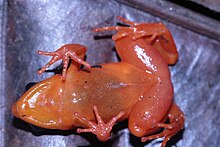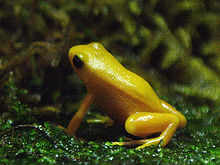Gold frogs
| Gold frogs | ||||||||||||
|---|---|---|---|---|---|---|---|---|---|---|---|---|

Golden frog ( Mantella aurantiaca ) |
||||||||||||
| Systematics | ||||||||||||
|
||||||||||||
| Scientific name | ||||||||||||
| Mantella aurantiaca | ||||||||||||
| Mocquard , 1900 |
The golden frog ( Mantella aurantiaca ) is a very small, predominantly ground-living species of the frog from the family of Madagascar frogs . The uniform orange coloration of these rare animals, which are only native to a small area on the island of Madagascar , is characteristic.
features
Adult frogs reach a head-trunk length of 19 to 24 millimeters, females occasionally also up to 31 mm. They are almost uniformly bright orange in color, with variations between yellow-orange and - at least in individual populations - red-orange . The belly side is often a little lighter than the top and slightly translucent. There may be red spots on the inside of the hind legs as well as on the flanks. The iris of the eyes is almost entirely black; only in the upper part there are lighter pigment spots. The horizontally positioned pupil is usually not clearly visible due to the black color of the iris. The females are not only slightly larger on average, but are also built a bit “wider”.
distribution and habitat
Gold frogs can only be found in an area of less than 10 km² in the east of Madagascar at heights between 920 and 960 meters. The range is narrowly limited to small forests in the area of the Torotorofotsy swamps near Andasibe . These forest areas are often characterized by the presence of screw trees ( Pandanus spp.).
The frogs mainly inhabit the damp to swampy litter layer on the ground, where they hide between leaves, moss and roots and are active during the day looking for small insects and the like. a. Invertebrate hunting. The climatic conditions of the habitats are characterized by specific temperature ranges. In the months of October to April these are between 18 and 25 ° C during the day. In the southern winter, from April to October, temperatures reach 15 to 20 ° C during the day and can drop to 10 ° C at night. The main rainy season falls between December and March; however, there are humid conditions all year round.
Due to the progressive deforestation and fragmentation of the area, the habitat and thus the species are severely threatened. The Mantella is on the red list of the IUCN (= acute threatened with extinction) as "critically endangered" classified.
Reproduction and Individual Development
During the mating season between November and January, the males utter irregular series of short clicks ("tiek-tiek"), which they generate with the help of a sound bubble . The females deposit hazelnut-sized, foamy clutches of around 20 to 60 whitish eggs in damp hiding places between fallen leaves. The tadpoles that hatch after about two weeks of embryonic development are washed into nearby waters by heavy rain or grow in pools formed from the precipitation. The metamorphosis to 9 to 11 mm large young frogs takes place after about 70 days. The young animals are initially dark brown with black diamond markings on their backs and change color around the age of eight weeks. They reach sexual maturity after a year.
toxicity
The skin of the brown-colored young frogs does not yet contain any toxins. In adults, on the other hand, alkaloids such as pumiliotoxins , allopumiliotoxins and homopumiliotoxins as well as pyrrolizidines , indolizidines and quinolizidines are present in the skin glands - as protection against bacterial and fungal attack and against predators. As with the South American poison dart frogs , the poison content depends on the range of food available from which the golden frogs extract and accumulate their poisons. Ants and termites are suspected to be the main sources. In captivity, golden frogs appear to gradually lose their toxicity.
Keeping and protecting species
Like all cichlid species, Mantella aurantiaca is a popular terrarium animal . In the 1990s in particular, there were extensive commercial exports from Madagascar. In addition to the destruction of the habitat, these have had a negative impact on the populations there, especially since the animals are also very sensitive to transport. Since 2006, the importation of wild-caught specimens of this species, which is listed in Appendix II of the Washington Convention on Endangered Species (CITES), has been completely prohibited in the European Union . Since then, the demand has to be met from captive-bred specimens, but the CITES regulations must be observed. Gold frogs are now kept and bred in around 35 zoos and similar institutions around the world.
Due to political unrest in Madagascar (government overthrow in spring 2009), compliance with and implementation of international species protection regulations is currently in question. It is feared that the situation could be used for renewed uncontrolled exports of rare, endangered species, including the gold frog.
swell
literature
- Rainer Schulte: frogs and toads. Ulmer-Verlag, Stuttgart 1980, ISBN 3-8001-7048-5 .
Web links
- Species portrait at Amphibiaweb.org (Engl.)
- IUCN Red List: Mantella aurantiaca (Engl .; including distribution map)
- More pictures of Mantella aurantiaca at calphotos.berkeley.edu



